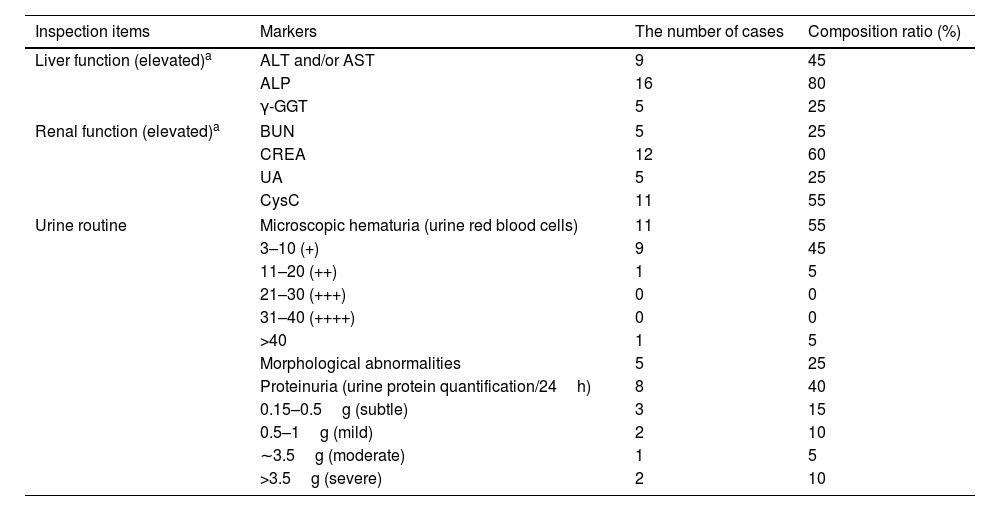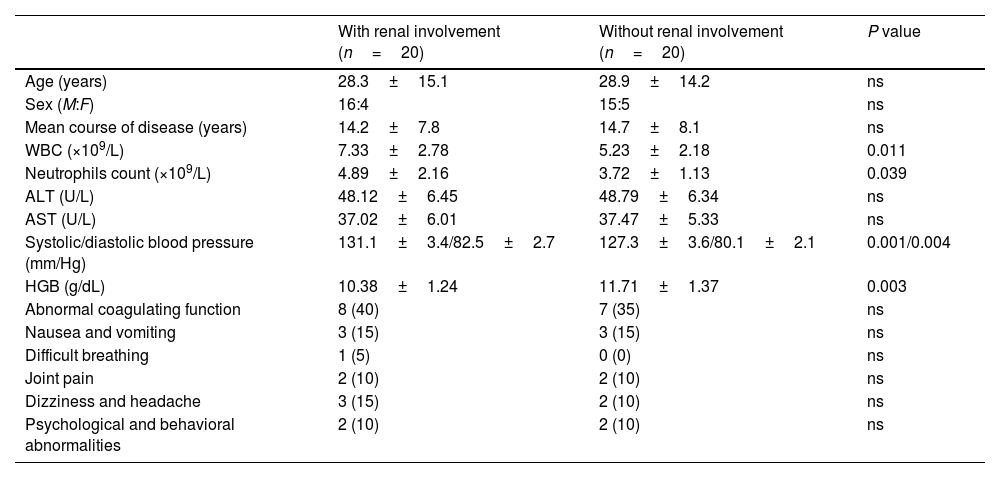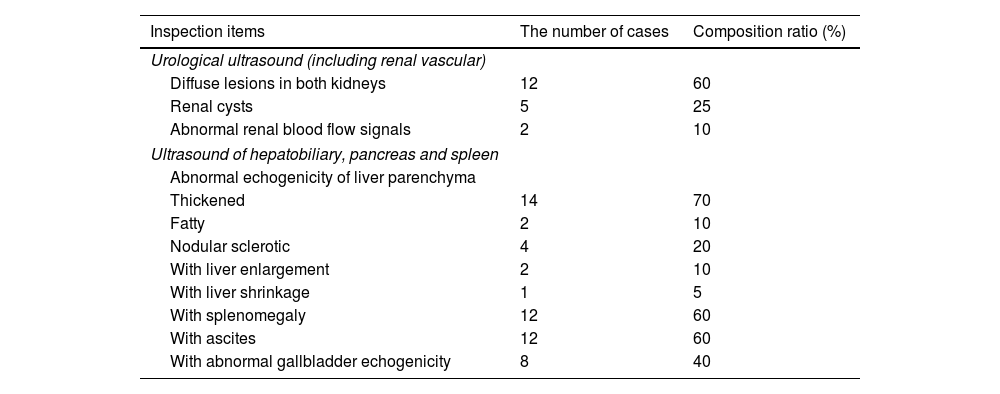Copper metabolism disorder disease is thought to contribute to renal symptoms in Wilson's disease (WD). Nonetheless, there remains limited knowledge regarding the precise characteristics of renal damage in individuals with Wilson's disease, encompassing clinical presentations, biochemical indicators, imaging findings, and renal histopathological alterations.
MethodsIn this study, 20 patients diagnosed with Wilson's disease and renal involvement were enrolled in our hospital. These patients met the validated European criteria for Wilson's disease, and those with primary kidney disease or secondary renal damage caused by other underlying conditions were excluded.
The baseline data of patients were collected. Various biochemical and hematological parameters were monitored. Biochemical examinations were measured using an automatic biochemistry analyzer, blood routines were tested by flow cytometry analysis, 24-h urine copper was tested by atomic absorption spectrophotometer. Besides, CER was measured by turbidimetric immunoassay with a Hitachi 7020 automatic biochemical analyzer (the intraplate and interplate coefficients of variation were 2.7% and 5.13% respectively). Copper oxidase was tested by colorimetric method using p-phenylenediamine hydrochloride (the intraplate and interplate coefficients of variation were both <10%). Diagnostic criteria for Wilson's disease and kidney damage were established based on the European Association for the Study of the Liver (EASL) and CKD Epidemiology Collaboration guidelines, respectively. Statistical analysis was carried out using t-tests and χ2 tests in SPSS 22.0 software. Significant differences were considered when P<0.05.
ResultsIn those patients with Wilson's disease-related renal damage, edema, gross hematuria, oliguria, and lumbar pain were present in most patients. Microscopic haematuria and proteinuria were also observed in 19 patients. Compared to patients without renal involvement, those with renal complications exhibited a significant increase in white blood cell (WBC) and neutrophil counts (P<0.05). Additionally, patients with renal damage showed a noteworthy rise in both diastolic and systolic blood pressure, along with a significant reduction in hemoglobin levels (P<0.05). Color Doppler ultrasound results revealed diffuse lesions in both kidneys in 12 patients, renal cysts were identified in 5 patients, and 2 patients exhibited abnormal renal blood flow signals. Meanwhile, varying degrees of IgA, IgM, IgG-based immunoglobulins, complement C3 and C1q deposition in the glomerular mesangial area were detected by immunofluorescence. Furthermore, renal puncture biopsy results revealed a spectrum of findings, including minimal change nephrosis in 1 case, IgA nephropathy in 3 cases, atypical membranous proliferative nephropathy in 2 cases, and focal segmental glomerulosclerosis in 1 case.
ConclusionThis study comprehensively elucidates the distinct attributes of renal damage related to Wilson's disease, while also speculating that renal dysfunction in Wilson's disease could be linked to immune complex deposition. Depending on the underlying pathogenesis, kidney injury associated with Wilson's disease can be classified as primary or secondary. To slow down the progression of renal impairment, it is essential to undergo a renal biopsy pathological examination as early as possible to clarify the type of impairment and take the appropriate treatment.
Se cree que los trastornos del metabolismo del cobre causan los síntomas renales de la enfermedad de Wilson (EW). Sin embargo, se sabe poco sobre las características exactas de la lesión renal en pacientes con enfermedad de Wilson, incluidas las manifestaciones clínicas, los marcadores bioquímicos, las manifestaciones de imagen y los cambios histopatológicos renales.
MétodosEn este estudio se incluyeron 20 pacientes diagnosticados de afectación renal relacionada con la enfermedad de Wilson en nuestro hospital. Estos pacientes cumplían los criterios europeos modificados de la enfermedad de Wilson, mientras que se excluyeron aquellos con enfermedad renal primaria o daño renal secundario causado por otras afecciones subyacentes.
Se recogió el estado general del paciente. Se analizaron diversos parámetros bioquímicos y hematológicos. Las pruebas bioquímicas se midieron con un analizador bioquímico totalmente automatizado. Los análisis de sangre rutinarios se midieron mediante citometría de flujo y el cobre en orina de 24 horas se midió con un espectrofotómetro de absorción atómica. Además, la RCE se midió mediante inmunoensayo turbidimétrico utilizando un analizador bioquímico Hitachi 7020 totalmente automatizado (los coeficientes de variación dentro de los grupos y entre ellos fueron del 2,7% y el 5,13%, respectivamente). La cobre oxidasa se midió por el método colorimétrico del clorhidrato de p-fenilendiamina (coeficiente de variación<10% tanto dentro de los grupos como entre ellos). Los criterios diagnósticos de la enfermedad de Wilson y la lesión renal se basaron en la Asociación Europea para el Estudio del Hígado (EASL) y las Directrices de Colaboración para la Epidemiología de la ERC, respectivamente. Los análisis estadísticos se realizaron con el programa SPSS 22.0 para la prueba t y la prueba χ2. Se consideraron diferencias significativas cuando p<0,05.
ResultadosEn los pacientes con lesión renal asociada a la enfermedad de Wilson, la mayoría de los pacientes presentan edema, hematuria macroscópica, oliguria y dolor de espalda. En 19 pacientes se observó hematuria microscópica y proteinuria. Los recuentos de glóbulos blancos (GB) y neutrófilos aumentaron significativamente en los pacientes con complicaciones renales en comparación con los que no presentaban afectación renal (p<0,05). Además, tanto la presión arterial diastólica como la sistólica fueron significativamente más altas y los niveles de hemoglobina fueron significativamente más bajos en los pacientes con lesión renal (p<0,05). Los resultados de la ecografía Doppler color mostraron lesiones difusas en ambos riñones en 12 pacientes, se hallaron quistes renales en 5 pacientes y señales anormales de flujo sanguíneo renal en 2 pacientes. Mediante inmunofluorescencia se detectaron diferentes grados de depósitos de inmunoglobulina IgA, IgM, IgG, complemento C3 y C1q en la zona de la túnica glomerular del paciente. Además, las biopsias renales por punción revelaron una serie de hallazgos que incluían un caso de nefropatía por lesión microscópica, 3 casos de nefropatía IgA, 2 casos de nefropatía membranoproliferativa atípica y un caso de glomeruloesclerosis segmentaria focal.
ConclusiónEste estudio elucida de forma exhaustiva las diferentes características de la lesión renal asociada a la enfermedad de Wilson y también especula que la disfunción renal en la enfermedad de Wilson puede estar relacionada con el depósito de inmunocomplejos. Dependiendo de la patogénesis subyacente, la lesión renal asociada a la enfermedad de Wilson puede clasificarse como primaria o secundaria. Para ralentizar la progresión de la lesión renal, es crucial realizar la patología de la biopsia renal lo antes posible para definir el tipo de lesión y adoptar un plan de tratamiento adecuado.










